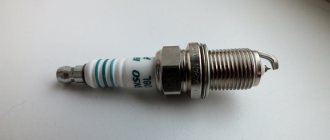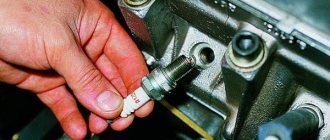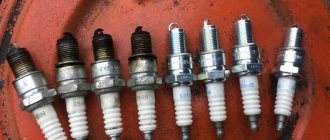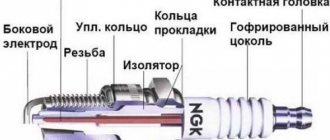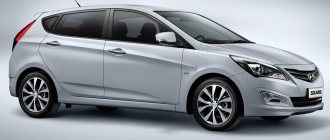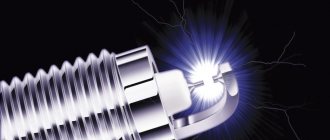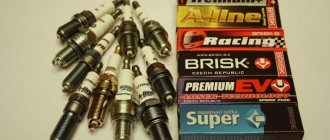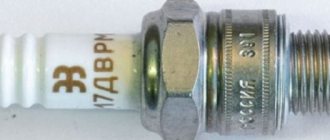The spark plug is a small, but very important part of any car, because thanks to it, ultimately, an electrical discharge is created, which guarantees a confident start of a cold engine, good throttle response, stable idling, no misfiring of the cylinders, etc. This is why it is so important to regularly (at every oil change) monitor the condition of the spark plugs and replace them on time. Moreover, it is better to do this replacement according to the manufacturer’s recommendations - with an original part, but, unfortunately, this is not always possible, fortunately there is such a thing as the interchangeability of spark plugs. The serviceability of spark plugs determines the efficiency of any internal combustion engine. This part may fail, requiring immediate replacement.
What can you change for what?! Let's look at the most common types of spark plugs in our country and their analogues.
Domestic or foreign, how to choose?
Different types of protective equipment from one manufacturer
Candles from foreign manufacturers do not have specific labeling requirements. Russian products must contain symbols indicating the following information:
- name of the manufacturer or company logo;
- date of manufacture;
- designation “made in Russia” or RUS;
- markings that comply with state standards.
Foreign candles are marked according to a similar principle to domestic devices. However, their designation is deciphered differently. Products of different brands, for example “BRISK” and “NGK” with the same parameters have different designations. The lack of generally accepted labeling standards greatly complicates the selection of an analogue. To choose the right SZ, you should use the spark plug interchangeability table or pay attention to the spark plug packaging, it contains information indicating which types of engines the SZ is suitable for.
Table. Selection of the main types of protective equipment from different brands based on compatibility.
If it is impossible to find an analogue for candles, then a dash is placed in the table.
Features of production technology
Frequency of replacement of spark plugs. spark plug tester. spark plug gap
One of the stages of manufacturing Bosch products Bosch engineers invented the world's first spark plug. Since then, BOSCH spark plugs have been installed by leading automakers when producing cars. This is due to the high quality of Bosch products, the compliance of their designs with generally accepted requirements. Depending on the design of the candle, the materials used in its manufacture, as well as the area of application of the SZ, various requirements are imposed on the manufactured products.
Bosch SZs are manufactured not only in Germany; their production is established in Brazil, Russia, China and other countries. At the same time, the same requirements are imposed on the quality of products, regardless of the country of origin. The same level of quality of products is ensured by the centralized preparation of contracts for the supply of raw materials. In addition, specialists from Germany work in other countries and carry out quality control of products.
The range of BOSCH spark plugs includes products for all types of transport; there are practically no car models on which it is impossible to install Bosch spark plugs. The ignition sections of this brand have proven themselves to be excellent for motor-boat transport, block heat and power plants and low-power engines, as well as in motorsports.
You can select BOSCH spark plugs by the markings on the product; you can also use the online catalog https://www.bosch-automotive-catalog.com/ru/ to select spark plugs.
According to the manufacturer's catalog, BOSCH spark plugs are used in various fields:
- cars with gas engines;
- two-wheelers;
- low-power engines;
- industrial equipment.
Please note that there are a lot of counterfeit products on the market, so the Bosch catalogs indicate how much SZ should be in the package, what marking is accepted by the manufacturer
How does a spark plug work?
Consists of the following elements:
- tip (contact pin);
- insulator ribs;
- insulator;
- base;
- seals;
- side electrode;
- central electrode;
- metal body;
- ring sealing.
Tip. Its task is to transmit voltage to the central electrode through a special conductive rod. On a high-quality candle, the tip should not unscrew. If it is removed, this indicates a low-quality product.
The insulator is made from a special ceramic material. The insulator has a wavy appearance; due to the parameters and number of waves, the voltage path can be lengthened.
Metal body. Looking at the body of the spark plug you can tell a lot. For example, whether it is of high quality or not, find out the manufacturer. If you can see rainbow tints on the case, then we can safely say that it is a fake, because the tints mean that the product has not completely undergone heat treatment.
Metal ring. The ring serves to create a tight connection between the spark plug and the cylinder block.
The internal seal is designed to fix the ceramic insulator and improve thermal conductivity.
The insulator cone (the base of the wavy insulator) can be in the shape of a barrel or a cone, it all depends on the purpose of the candle. Inside it there is a central electrode, based on the appearance of which, the operation of a particular cylinder can be characterized.
We recommend: Traction batteries for trucks and tractors
The technological chamfer makes it easier to fit the spark plug into the cylinder head.
Side electrode. It has a curved shape at 90º C, and contains platinum plating, which improves its properties and long service life. There may be several side electrodes in the package.
Air gap. The space between the ceramic insulator and the metal body is designed to reduce and self-clean carbon deposits. The gap size is indicated by the last digits in the model name.
Central electrode. It is made of special alloys that are resistant to high temperatures and can have different heights and diameters.
Ceramic body. Its presence allows you to isolate the central electrode from the ground and can withstand a voltage of 50 kV.
There is a thread on the body with which the spark plug is attached to the cylinder head. The body has a turnkey hexagon shape and is coated with a special anti-corrosion substance. The supporting surface can be either conical or flat. The spark plug ring serves as a sealing element for the spark plug hole. High quality ceramics are used for insulation. To avoid loss of electricity, special grooves are provided on its surface, onto which glaze is applied, and the insulator area on the side of the combustion chamber is made in the form of a cone. In the middle of the ceramic part there is a central electrode and a contact rod, and perhaps a resistor is located between them. It is designed to suppress possible radio interference. The side electrode is welded to the metal body. Alloys for electrodes have high heat resistance. In order to maximize service life, spark plugs are introduced that have several side electrodes, which are coated with a ball of platinum or iridium. Their service life is up to 100,000 km.
Rear
For clarity, we recommend watching a video about replacing the rear brake pads on a VAZ 2110. This will make it easier to complete the task and have a visual representation of each stage of repairing the brake system.
It will be good if you once installed disc elements on your rear brakes. The beauty of them is that the process of replacing the rear pads will be similar to the front ones.
The situation is completely different for those who use factory drum braking systems. The work will have to be done delicately, but completely achievable on your own.
To get started, arm yourself with a set of tools, which includes:
- Balloon wrench;
- Jack;
- Pliers;
- Screwdriver;
- Hammer;
- Sharp chisel;
- Open-end, socket and ring wrench sizes 12, 13 and 17 - 3 sizes of each type of wrench.
Now we proceed directly to replacing the rear brake pads.
- Place chocks under the front wheels and remove the rear wheel.
- Unscrew the guides using a 12mm wrench.
- Guides are required for fixing to the axle shafts of the drums.
- It may be quite difficult to remove the drum from its place. This is where you will need a hammer and a wooden stand. Tap the inside of the drum. It is strongly not recommended to hit the drum directly with a metal hammer, as the mechanism may be damaged.
- If the drum cannot be removed even after hammering, treat the contact areas with the hub with WD40 or other penetrating lubricants.
- Then, arm yourself with pliers and remove the springs from the bottom and top of the pads.
- Remove the guide spring located in front.
- This will allow you to completely remove the block.
- When the bar is removed, you can begin to remove the spring from the rear pad.
- Well, now remove both parts of the block. When removing the back one, remember the hook. It comes from the handbrake cable.
- After removing the old block, put a new one in its place. Assembly is carried out in reverse order.
- But there is one caveat - the bushing must be removed from the drive arm, which will greatly facilitate the reassembly process. The upper part of the pads is inserted into the grooves located on the cylinder rod.
- Be prepared for the fact that certain difficulties may arise when installing a new element. The reason is the large output that remains as a result of the operation of old brake elements.
- Take two pry bars and squeeze the two blocks together to bring them as close as possible. At this point the replacement can be considered completed.
- At the last stage, mandatory bleeding of the brake system is carried out. Without it, not a single intervention in the design of car brakes can be done.
Which brand of spark plug should I choose?
There are several types of candles. Two or more electrodes, torch design, plasma torch ignition. All manufacturers have in their assortment spark plugs with different types of electrodes.
Here are the best of them:
1. BOSCH
2.NGK
3. CHAMPION
4. BRISK
5. DENSO
The choice of manufacturer is not as important as the choice of model and manufacturing technology.
Nevertheless, some features of the brands can be highlighted:
- Bosch has an agreement for OEM supplies for Mitsubishi, Fiat, Audi, Peugeot, Toyota.
- NGK cooperates with such automakers as Ferrari, Ford, Volkswagen, Volvo, BMW.
- Champion works for Suzuki, GM, Jaguar, Volvo, Alfa Romeo.
- Brisk produces spark plugs with the logo of Audi, Opel, Skoda and BMW.
Accordingly, by purchasing a spark plug with the logo of the manufacturer that produces products for your car brand, you will simply save money without losing quality. Often the part number of the product matches the car make and the original name of the manufacturer on consumables.
Recommendations:
6 best car batteries
8 best car lamps in H7 socket
Briefly about the company
Bosch company logo
A small workshop of precision mechanics and electrical engineering, opened by Robert Bosch in 1886, over the course of several years grew into the world-famous BOSCH company, which has representative offices in many countries. Already in 1906, the Bosch sales department took an order, the cost of which was more than 1 million dollars. Main sectors and branches of activity of Bosch:
- Auto parts and auto equipment.
- Automotive components and systems.
- Electrical tools.
- Appliances
- Security systems
- Industrial equipment.
- Packaging technology
- Construction technologies and energy.
BOSCH has managed to take a leading position in many industries thanks to the patent system. The manufacturer's patents are registered all over the world, allowing other companies to use Bosch's developments as licensees. Bosch offers a wide range of services, for example, when designing an automobile plant, safety standards are taken into account, ventilation, heating, and energy saving systems are developed. In the automotive industry, the main technical solutions are aimed at introducing innovative technologies that improve comfort and driving safety, increase the efficiency of cars and reduce the harmful impact of cars on the environment.
The company has many developments to its credit, for example:
- serial introduction of the world's first electric injection system (Jetronic) with adjustable pressure for gasoline engines.
- development of the ABS braking system;
- introduction of a traction control system;
- manufacturing of DI Motronic gasoline direct injection systems;
- development of a special diesel fuel injection system to improve the environmental friendliness of cars.
We recommend watching a video about the features of Bosch spark plug production:
https://youtube.com/watch?v=_W9K_Qh1RSM
Spark plug interchangeability table.
Note. * non-standard designation of a spark plug with two “ground” electrodes. n.d. - no data. The completeness and spark gaps of analogue spark plugs may differ.
Now let's look at the table in more detail.
A17DV.
Country of origin: Russia.
On which cars it is used: VAZ 2101-2107 and their modifications until 1988.
Analogues:
- BOSCH (Germany) – W7D;
- NIPPON (Japan) – DENCO W20EP-U;
- NGK (Japan) – BP6ES;
- AC DELCO (USA) – 42XLS;
- BRISK (Czech Republic) – L15YC;
- BERU (Germany) – 14-7DU;
- CHAMPION (USA) – N9Y;
- EYQUEN (France, Italy) – 750LS.
We recommend: Which oil is better 5w40 or 10w40, what is the difference?
A17DVM.
Country of origin: Russia.
On which cars it is used: VAZ 2101-2107 and their modifications until 1988.
Analogues:
- BOSCH (Germany) – W7DC;
- NIPPON (Japan) – W20EP-U;
- AC DELCO (USA) - C42XLC;
- BRISK (Czech Republic) – L15YC;
- CHAMPION (USA) – N9YC;
- NGK (Japan) – BP6ES;
- BERU (Germany) – 14-7DU;
- EYQUEM (France, Italy) – C62LS.
A17DVRM.
Country of origin: Russia.
On which cars it is used: VAZ 2104-2111 and all their modifications.
Analogues:
- BERU (Germany) – 14R-7DU;
- BOSCH (Germany) – WR7DC;
- NIPPON (Japan) – W20EPR;
- AC DELCO (USA) – CR42XLC;
- BRISK (Czech Republic) – LR15YC;
- NGK (Japan) – BPR6ES;
- CHAMPION (USA) – RN9YC.
A10.
Country of origin: Russia.
On what vehicles is it used: ZIL-157KD and its modifications.
Analogues:
- BOSCH (Germany) – W9AC;
- AC DELCO (USA) – 46F;
- BRISK (Czech Republic) – N19;
- NGK (Japan) – B4H;
- BERU (Germany) – 14-10A;
- AUTO LITE (USA) – 416;
- CHAMPION (USA) – L90.
A20D.
Country of origin: Russia.
On what vehicles is it used: AZLK, IZH.
Analogues:
- BOSCH (Germany) – W6CC;
- MARELLI (Italy) – 7LPR;
- BRISK (Czech Republic) – L14;
- NGK (Japan) – B7ES;
- BERU (Germany) – 14-6CU;
- AUTO LITE (USA) – 4054;
- CHAMPION (USA) – N3C.
A14B and A14B-2.
Country of origin: Russia.
On which vehicles is it used:
- GAZ-24;
- buses: RAF, ErAZ;
- motorcycles: “Dnepr” and “Ural”.
Analogues:
- BOSCH (Germany) – W8BC;
- AC DELCO (USA) – 43FS;
- BRISK (Czech Republic) – N17YC;
- NGK (Japan) – BP5HS;
- BERU (Germany) – 14-8B;
- CHAMPION (USA) – L92YC;
- AUTO LITE (USA) – 275;
- MARELLI (Italy) – F7NC;
- NIPPON (Japan) – W14FP;
- EYQUEN (France, Italy) – 550S.
A14D.
Country of origin: Russia.
On what cars is it used: GAZ-3102.
Analogues:
- BOSCH (Germany) - W8CC;
- BRISK (Czech Republic) – L17C;
- NGK (Japan) – B5ES;
- BERU (Germany) – 14-8C;
- CHAMPION (USA) – N5C;
- AC DELCO (USA) – 43XL;
- MARELLI (Italy) – CW6L;
- NIPPON (Japan) – W17ES;
- AUTO LITE (USA) – 394;
- EYQUEN (France, Italy) – 600L.
A11 and A11-3.
Country of origin: Russia.
On which cars it is used: GAZ, ZIL, UAZ.
Analogues:
- BOSCH (Germany) – W9AC;
- BRISK (Czech Republic) – N19;
- NGK (Japan) – B4H;
- BERU (Germany) – 14-10A;
- CHAMPION (USA) – L86C;
- AUTO LITE (USA) – 416;
- MARELLI (Italy) – CW4N;
- AC DELCO (USA) – 45F, 420Z;
- EYQUEN (France, Italy) – 406.
A14DV.
Country of origin: Russia.
On what cars is it used: GAZ-14, GAZ-3102 and its modifications.
Analogues:
- BOSCH (Germany) – W8DC;
- AC DELCO (USA) – 43XLS;
- BRISK (Czech Republic) – L17C;
- NGK (Japan) – BP5ES;
- BERU (Germany) – 14-8DU;
- CHAMPION (USA) – N11YC;
- MARELLI (Italy) – CW6LP;
- AUTO LITE (USA) – 55;
- EYQUEN (France, Italy) – 600LS.
The main criteria by which selection is carried out
Products from various brands
Modern motors are manufactured with certain design features that provide them with certain technical characteristics. For normal operation of the power unit, it is necessary to install the SZ, with certain parameters corresponding to the type of car engine. When choosing an analogue of SZ, you should pay attention to their main parameters:
- Screw-in dimensions:
- length of the threaded part;
- thread pitch;
- thread diameter;
- turnkey hexagon dimensions.
We recommend: Choosing a clutch kit for a car: Luk, Kraft or Valeo
Products with overall and connecting dimensions that do not correspond to the engine type cannot be mounted on the power unit. The use of devices with a threaded part that is too long or short, in most cases ends in a major overhaul of the car engine.
- The thermal part of the analogue should be as close as possible to the characteristics of the original. We are talking about the heat number, which reflects the ability of candle products to heat up at different thermal loads of the engine. Please note, when selecting SZ for compatibility, that domestic products are marked indicating the heat number, while foreign ones are divided into cold (having a large heat number) and hot (having a small heat number).
- The distance between the spark plug contacts must correspond to the size specified in the machine manual. An increased spark plug gap will lead to a decrease in spark power, and a reduced gap will lead to breakdowns in the ignition system.
- Number of spark plug electrodes. Many motorists are of the opinion: the more spark plug contacts, the stronger the sparking. This is an erroneous statement; the spark occurs between two contacts. In multi-contact devices, the operating principle is as follows: if one electrode burns, sparking will occur on the second. Such modernization of the SZ design makes it possible to increase their operational period, but does not affect the spark power.
- The material from which the spark plug contacts are made. It is possible to buy iridium, platinum or classic candles. The operational period of the product, the rate of formation and the power of the spark depend on the material of their contacts.
You can buy various spare parts for your car at https://tdbovid.ru/katalog_zapchastej
Rear
For clarity, we recommend watching a video about replacing the rear brake pads on a VAZ 2110. This will make it easier to complete the task and have a visual representation of each stage of repairing the brake system.
It will be good if you once installed disc elements on your rear brakes. The beauty of them is that the process of replacing the rear pads will be similar to the front ones.
In some cases, depending on the design of the rear brakes, it may be necessary to completely remove the rotor and caliper. All other activities are carried out in exactly the same way as in the case of the front pads.
The situation is completely different for those who use factory drum braking systems. The work will have to be done delicately, but completely achievable on your own.
To get started, arm yourself with a set of tools, which includes:
- Balloon wrench;
- Jack;
- Pliers;
- Screwdriver;
- Hammer;
- Sharp chisel;
- Open-end, socket and ring wrench sizes 12, 13 and 17 - 3 sizes of each type of wrench.
Now we proceed directly to replacing the rear brake pads.
- Place chocks under the front wheels and remove the rear wheel.
- Unscrew the guides using a 12mm wrench.
- Guides are required for fixing to the axle shafts of the drums.
- It may be quite difficult to remove the drum from its place. This is where you will need a hammer and a wooden stand. Tap the inside of the drum. It is strongly not recommended to hit the drum directly with a metal hammer, as the mechanism may be damaged.
- If the drum cannot be removed even after hammering, treat the contact areas with the hub with WD40 or other penetrating lubricants.
- Then, arm yourself with pliers and remove the springs from the bottom and top of the pads.
- Remove the guide spring located in front.
- This will allow you to completely remove the block.
- When the bar is removed, you can begin to remove the spring from the rear pad.
- Well, now remove both parts of the block. When removing the back one, remember the hook. It comes from the handbrake cable.
- After removing the old block, put a new one in its place. Assembly is carried out in reverse order.
- But there is one caveat - the bushing must be removed from the drive arm, which will greatly facilitate the reassembly process. The upper part of the pads is inserted into the grooves located on the cylinder rod.
- Be prepared for the fact that certain difficulties may arise when installing a new element. The reason is the large output that remains as a result of the operation of old brake elements.
- Take two pry bars and squeeze the two blocks together to bring them as close as possible. At this point the replacement can be considered completed.
- At the last stage, mandatory bleeding of the brake system is carried out. Without it, not a single intervention in the design of car brakes can be done.
As you can see, replacing the pads is not difficult if you act consistently. The best option is to install disc brakes everywhere. They are easier to work with, they are more efficient in their tasks, plus replacement is carried out without any problems, unlike drums.
Candle parameters
Overall and connecting dimensions are the pitch and diameter of the thread on the contact part, which is screwed into the cylinder, the size of the hexagon and the length of the threaded part. These dimensions correspond to each individual type of engine, since the seat on the cylinders has its own design size.
The drip number is an indicator of the level of thermal property that shows how the plug heats up depending on the various thermal loads of the engine. If it has a small drop number, then it is called hot. Its thermal cone heats up to 900º C. They are used on low-power engines with a low compression ratio. Cold spark plugs are those in which ignition occurs under high thermal loads; accordingly, they are used for highly accelerated engines.
The size of the spark gap. This value is usually indicated in the vehicle operating rules and has limits from 0.5 to 2 mm. The gap can be structurally adjustable.

